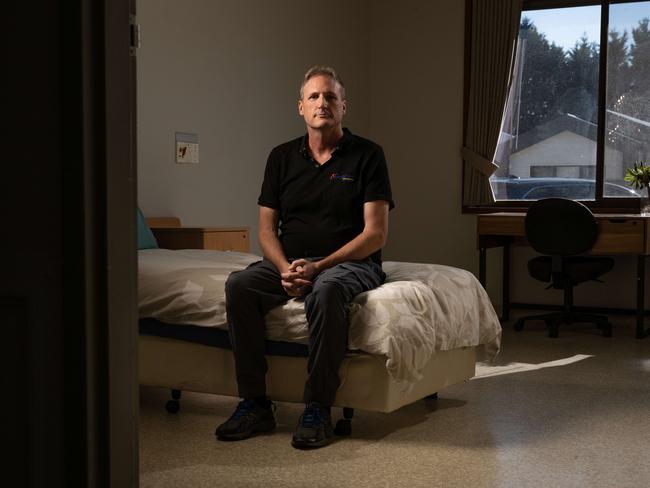Inside cocaine rehab: How Australian drug users recover
Staff at a Geelong facility have revealed the surprising number of Aussies who fall victim to addiction - and why others don’t. Watch the video to see how they help addicts recover.
Cocaine Inc
Don't miss out on the headlines from Cocaine Inc. Followed categories will be added to My News.
From its brick exterior to living areas adorned with artworks, industrial-style kitchen and garden bathed in the sunlight it could be any suburban home in any street anywhere in the country.
But for those who go through its doors - it could be the difference between their freedom or jail - or worse.
People come from all over Australia to Habitat Therapeutics – one of hundreds of rehabilitation centres across the country. This one is in Geelong, about 74km south west of Melbourne, used to be an aged care home. It now plays home to those desperate to kick their drug and alcohol addictions.
While the majority of Habitat Therapeutics’ clients are battling methamphetamine and alcohol addictions, about 10 per cent have a cocaine problem.
Co-directors Jim Tatlock and David Forbes see first-hand how cocaine addiction can strike anyone.
Watch the video above to see more in our Cocaine Inc. investigation.
Do you know more? Contact us at cocaineinc@news.com.au

“Cocaine users are normally mid 20s and above, they can be doctors, nurses, teachers, chefs, labourers,” Mr Tatlock said.
“There is no clear link there as to who’s likely to fall victim to the addiction of cocaine
“Quite often it starts because it’s was a fun party drug to hang out with people and use,” Mr Tatlock said.
But that can lead to addiction “very quickly” for about one in 10 Australians.
Watch the video and see what a cocaine rehab centre is like below:
Mr Tatlock said many users mistakenly believe cocaine lacked the harmful impacts of other drugs - and could handle whatever it threw at them.
“When you’re talking about high achieving people that are in high performance jobs, in their own mindset, and quite accurately, they’ve been able to achieve great things in their career,” he said.
“I think possibly at times they would think that ‘I can manage this drug use, it’s just a party drug.”

In fact, they’re at risk from both physical and psychological damage, he said.
“When you’re talking about medical things, we’ve had people that have actually got holes in their noses attend here, from using cocaine,” Mr Tatlock said.
“And then the other side is actually psychosis. They overload their brain with the use of cocaine and that can lead to disastrous effects in the community.”
Listen to the Cocaine Inc. podcast below:
Most clients are referred to Habitat by worried family members who are alarmed their loved ones are close to hitting rock bottom. That, and self-referral, have a better chance of recovery than those directed to attend by the courts who are “often just trying to stay out of jail”.
The high cost of cocaine meant an addiction eventually caused their lives to unravel.

“If it leads to job loss or anything along those lines, then obviously mortgage stress, family stress, all those sorts of things [follow]. People might often use cocaine, but end up on drugs that are cheaper,” Mr Tatlock
Methamphetamine is usually the drug they turn to.
“They’re likely to look for a cheaper alternative and, and Methamphetamine is going to be significantly cheaper,” Mr Tatlock said.
“We also do a lot of treatment with alcohol which is often linked to cocaine use,” Mr Tatlock said.
That’s due to the fact cocaine is almost always consumed with alcohol.

Co-director Mr Forbes said the key to helping clients get clean is to break them away from the lifestyle that got them trapped in the first place.
The centre offers 30, 60, and 90 day programs that run six days a week starting at 7.30am and finishing at 9pm.
“The first few days, it becomes very, very uncomfortable. But as the number of days grows, it becomes more and more comfortable dealing with life without the use of any drug,” Mr Forbes said.
The program focuses on education and life skills and removing the need for “instant gratification”.

Every morning clients discuss how their night has been and how they’re feeling as they sit together in a room that could have been a waiting area in its former life.
Small gardens bathed in sunlight that once played host to the elderly, now offer respite in a new way.
“It’s about how to do life without the need for an external substance, how to manage anger, how to manage stress, how to manage relationships and things not going the way you want them to go,” Mr Forbes said.

There are living areas - many with artwork featuring uplifting quotes - for time out and where phone use is banned.
Mr Forbes said the longer clients spent with them, the more equipped they were to make better choices when they were back in the real world and confronted with temptation.
“Hopefully by the time they leave here, they’ve experienced enough emotions and setbacks and things like that. So that when they do get back out there into life and put up with those sorts of things, they can hopefully use the tools that we’ve taught them, rather than resorting to the drug use.”
More Coverage
Originally published as Inside cocaine rehab: How Australian drug users recover





